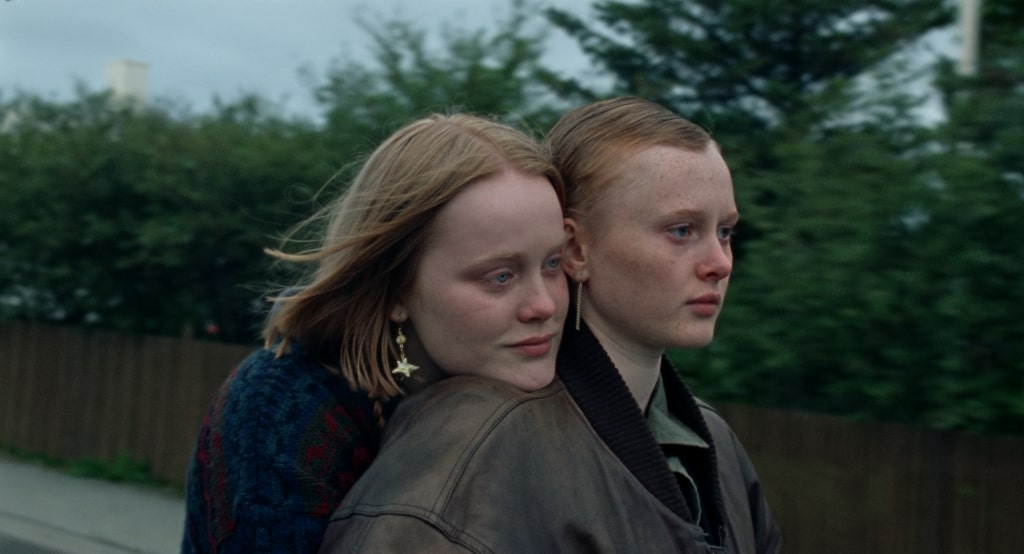Review by Khalid Ali, film and media correspondent
When the Light Breaks (Ljósbrot) (Rúnar Rúnarsson, Iceland, 2024)
Showing at the LFF 16th and 17th October 2024
Research that explores the impact on adolescents of the sudden death of their peers is scarce.1 Rúnar Rúnarsson masterfully addresses this gap in ‘When the light breaks,’ a character study of a group of friends during the 24 hours after their friend Diddi (Baldur Einarsson) dies in a tunnel accident. The focus is on Una (Elin Hall) and Klara (Katla Njálsdóttir), the two young women in Diddi’s life, Klara being his girlfriend in a long-distance relationship. On the day of the accident, Diddi had been driving to break the news to Klara in person that he would be ending their relationship, having fallen in love with Una. The new lovers met at university where Una studies art and Diddi is studying drama; the film’s opening shows them planning their future together after graduation. Until now, Diddi and Una’s budding romance has been kept secret from their close friends.
Over the course of 24 hours, Klara, Una, and three of Diddi’s friends Gunni (Mikael Kaaber), Siggi (Gunnar Hrafn Kristjánsson), and Bassi (Ágúst Wigum) commemorate his life by dancing, drinking and reminiscing over their cherished memories with him. As the members of this group celebrate their friendship with Diddi, peer support is shown to be a key factor in helping them come to terms with a devastating, unexpected loss. By hugging and holding each other at this moment of trauma, the friends demonstrate unity in facing their loss together. This is a central motif of the film, repeatedly seen and emphasising the power of a hug to convey a multitude of emotions.

However, Una is tormented by the fact that she is now side-lined. Her grief is not acknowledged, as no one else in the group, apart from Gunni, knows the nature of her relationship with Diddi. All the attention and sympathy are directed towards Klara. Initially Una and Klara show mutual hostility, as Klara suspects that Una had been more than a ‘friend’ to Diddi and ridicules her for studying drama. However, Una resists the urge to reveal the full, hurtful truth to Klara showing kind and dignified restraint.
A brief meeting with Una’s father shows that she realises the similarities between adolescence and adult life when he asks her not to tell her mother (his wife) that he is indulging in junk food. She bargains that she will keep his secret only if he does not tell her mother that she is smoking again. Una now appreciates the absurdity of life; her father, the supposedly mature adult, is acting like an adolescent by hiding a trivial secret. It is not only young adults like her who keep secrets such as her relationship with Diddi, adults do lie too.
By the end of this minimalist yet impactful 82-minute film, Una and Klara (elegantly portrayed by the two lead female actors) understand that their grief and bereavement unite them more meaningfully than painful and unnecessary jealousy and resentment. A scene where they stand next to each other cleaning their teeth in front of a mirror in Diddi’s flat, wearing the same colour T shirt, speaks volumes about their new kinship. In another scene beside they sea, where Una and Diddi used to meet, Klara muses that “it will be so strange to wake up tomorrow,” Una asks “Do you know what you will do, any plans?”, to which Klara replies; “I have no idea”. The future is unknown, but it is already evident that they will both grow into adults whose lives will forever be influenced by their joint loss. They are moving on with life, having gained a vital measure of wisdom and maturity.
Post-traumatic growth (PTG) is described as “a significant beneficial change in cognitive and emotional life that may have behavioural implications.”2 Individuals who experience PTG can emerge with several positive changes, such as higher appreciation of life, more compassion for others, and the thought of new possibilities.3 While they remember their collective loss, they can still move on with life.4 In addition, a stable continuing bond can be established between the deceased peers. ‘When the light breaks’ captures the key themes of PTG poignantly as Una and Klara contend with loss and develop into resilient characters who are almost ready to face their future. They might even become close friends after the light breaks.
Read Khalid Ali’s review of Utøya 22. juli on the Medical Humanities blog.
References
[1] Noppe, I. C. and Meyer, K. J. (2014). Accidents and traumatic loss: The adolescent experience. In K. J. Doka and A. S. Tucci (Eds.), (2014). Helping adolescents cope with loss (pp. 117-13). Washington, DC: Hospice Foundation of America.
[2] Tedeschi, R. G., Park, C., and Calhoun, L. G. (1998). Posttraumatic growth: Conceptual issues. In R. Tedescho, C. Parkes, and L. Calhoun (Eds.), Posttraumatic growth: Positive changes in the aftermath of crisis (pp.1-22). London: Erlbaum.
[3] McClatchey IS. Trauma-Informed Care and Posttraumatic Growth Among Bereaved Youth: A Pilot Study. Omega (Westport). 2020 Dec;82(2):196-213. doi: 10.1177/0030222818804629. Epub 2018 Oct 10. PMID: 30303460.
[4] Papadatou D, Bellali T, Tselepi K, Giannopoulou I. Adolescents’ trajectory through peer loss after a road traffic accident. Death Stud. 2018 Jul;42(6):383-391. doi: 10.1080/07481187.2017.1355341. Epub 2017 Aug 23. PMID: 28726591.